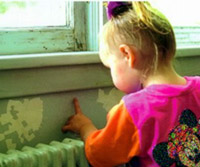
Lead-Based Paint
About 75 percent of Illinois homes built before 1978 contain some lead-based paint. Lead-based paint was used both inside and outside of homes, especially on windows, baseboards, trim and doors to ensure its durability. After many years of exposure to moisture and climate changes, the paint begins to deteriorate, causing lead dust and chips to settle in window wells, and on door frames and porches. Even the deepest layers of lead-based paint can be disturbed during remodeling or home repair. The only way to know for sure if your home contains lead-based paint is to have it tested by a licensed lead professional. You can search for a licensed lead inspector or risk assessor in your area using the links located on this page. You also may get a list of lead contractors that are qualified to remove any lead-based paint or lead hazards identified in your home. The Illinois Department of Public Health’s Lead Program employs regional and local health department staff to inspect the dwellings of children who exhibit elevated blood lead levels. Homes with hazardous lead-based paint conditions are required to have the paint or the component that is coated with lead-based paint removed. The Department’s Lead Program licenses lead paint inspectors, lead risk assessors, lead abatement contractors, lead supervisors, and lead workers. The Lead Program also approves lead training courses for individuals; a list of these may be retrieved by using the link located below.
|
 Lead poisoning, the No. 1 environmental illness of children, is caused primarily by lead-based paint in older homes. Illinois has higher rates of lead poisoning among its children than any other state in the nation. In 2008, more than 5,000 Illinois children were identified with elevated blood lead levels. The most common exposure to lead by children is through the ingestion of paint chips and contaminated dust from deteriorated or disturbed lead-based paint in homes built before 1978.
Lead poisoning, the No. 1 environmental illness of children, is caused primarily by lead-based paint in older homes. Illinois has higher rates of lead poisoning among its children than any other state in the nation. In 2008, more than 5,000 Illinois children were identified with elevated blood lead levels. The most common exposure to lead by children is through the ingestion of paint chips and contaminated dust from deteriorated or disturbed lead-based paint in homes built before 1978.